Learning commodity trading signals will open the door to profits in trading commodity futures. Commodity and Futures Training using Candlestick chart patterns allows traders to learn what Japanese rice traders knew centuries ago. The market can tell you what the market will do if you learn how to read the commodity trading signals. There are a dozen Candlestick patterns that traders should commit to memory and another 28 that can reliably predict market behavior. Candlestick charting techniques have a long and successful history of predicting commodity market movement. Candlestick trading tactics are like most tactics derived from technical analysis. Candlestick basics predict market activity and the trader either buys or sells commodities based on the insight derived.
Successful commodities traders start with a solid foundation of fundamental analysis of the commodity or commodities that they trade. There are reasonable limits to prices on a commodities exchange. Knowing where these limits are will help guide successful commodities trading. Within the extremes technical analysis tools can give solid commodity trading signals. Major Candlestick signals include the Doji, Bullish Engulfing, and Bearish Engulfing signals. Candlestick chart analysis can also be done with time honored commodity trading signals such as the Tri Star Pattern, the Three Black Crows, the Three Identical Crows, and the Two Crows patterns. All of these are secondary patterns typically indicating market reversals. A Commodity and Futures Training class will help the beginner learn both the fundamental and technical aspects of the commodities markets.
Commodity trading signals can be useful to both the companies buying commodities or the producers in hedging investment risk. Trading signals may be more useful to traders who routinely buy and sell commodities or who trade options on commodity futures. Although those hedging risk in the commodities markets may buy and sell once or twice a year the trader can and will watch the market throughout the year and throughout the day looking for commodity trading signals that will lead to profit. The addition of traders speculating on commodity prices adds volume and liquidity to the market leading to more traders trading and increasing volume. It is with high trading volume and liquidity that commodity trading signals work the best and are most profitable when followed.
Technical trading works best when applied through a trading strategy. The trader will learn with time which trading signals can be used to make the most profit. With experience the trader can learn more and more efficient execution of the trading strategy. The trader will learn which commodities he or she trades most effectively and which trading signals derived from Candlestick charts are most predictive of market changes for the commodity in question. With competent instruction the trader can learn effective use trading signals coupled with the use of techniques such as Candlestick trading tactics to make consistent profits. At the same time proper reading of market signals will help reduce risk while enhancing return on investment. For those interested in trading options on commodity futures a good choice is to take options training with Stephen Bigalow.
Market Direction
Investor sentiment is the force that moves prices/markets. Candlestick signals reveal the nature of investor sentiment. The signals work extremely well on their own. However, an investor can glean an immense amount of information utilizing candlestick signals and the other obvious information a chart is revealing. Today, the markets experienced a severe selloff on the open. This made for further confirmation of the possible reversal in the trend if you include the Evening Star signal that formed in the Dow last week. How does one know whether it is time to close out long positions when the market opens lower like it did today? They don’t! But they have to take a look at what was affecting the trend to this point. The tee line has acted as support for this uptrend for the past two months. That fact has to be put into the evaluation.
The longer a trend remains in existence, the more severe the reversal signal needs to be. Recently the markets have been reacting to positive or negative earnings reports on a daily basis. The overall trend has remained consistently above the tee line. The severe selling on today’s open was scary. However, up to this point, the trend had been fairly solid. It is prudent to not react until the daily signal confirms there has been a change of investor sentiment. As was witnessed today, the buying came back into the markets after about one hour of languishing near the lows. The intraday charts should have been utilized to see what the trend was doing. If the five-minute chart demonstrated a lengthy flat trading range, there is extreme hurry to close out the positions. They are probably already trading off after the selloff. If the markets appeared as if they were going to close at the low end of the trading range by the end of the day, then you could be selling those positions, probably at approximately the same level as were they were trading one hour after the open.

DOW
If the Bulls step back in, as they have done for the last two months, and close the markets above the tee line, a very simple assumption can be made. The uptrend is in progress as long as they cannot close it below the tee line.
Waiting to see what investor sentiment is doing after any price opens becomes a very prudent entry and exit strategy. As seen in the TLEO chart, it opened positive. It also started selling off immediately from that level. What should be witnessed after a candlestick buy signal? Continued buying! In the case of TLEO, there is nothing wrong with waiting one or two minutes to see if the buyers are still participating after the price opens positive following day candlestick buy signal.

TLEO
@How the markets closed today would be very important for indicating what was occurring an investor sentiment. Obviously a close at the lower end of today’s trading range would reveal the tee line had not acted as support. You do not have to buy at the absolute bottom or sell at the absolute top. Your entry and exit strategies should include practices that improve the probabilities for profiting from that trade.
No Chat Session Tonight due to Traveling
Good Investing,
The Candlestick Forum Team
Speak Your Mind